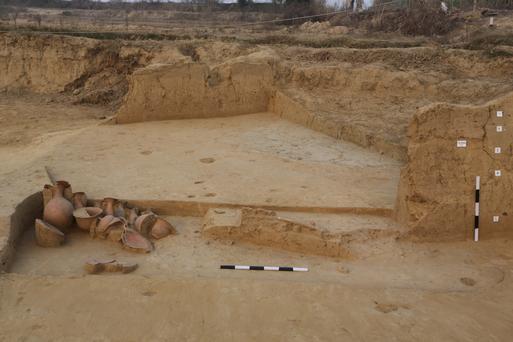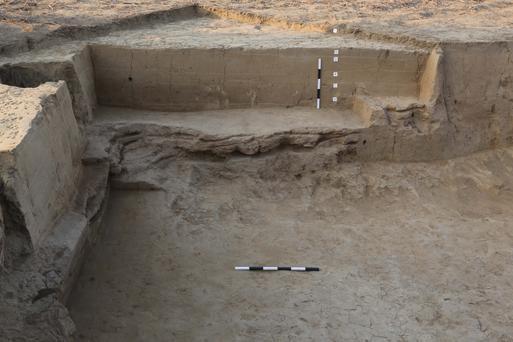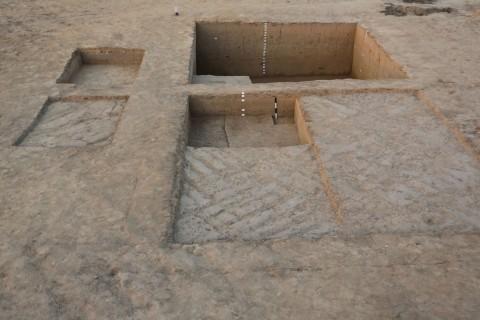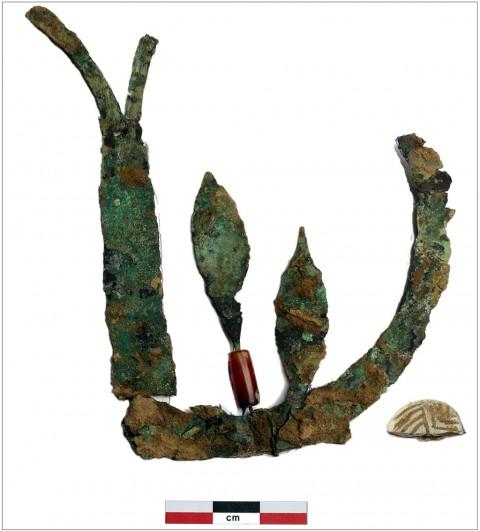T.S. Subramanian
Source - http://www.thehindu.com/news/national/excavation-at-harappan-site-reveals-house-plan/article6749380.ece?

A part of the 21 pots found at the burial pit in the late Harappan site of Chandayan, Baghpat district, Uttar Pradesh.
Remains of skeleton, animal bones indicate funeral ceremony at late-Harappan site
Excavation conducted by the Archaeological Survey of India (ASI) at the late-Harappan site of Chandayan in Uttar Pradesh has, for the first time, revealed the plan of a house on the Ganga-Yamuna doab, with its mud walls, four successive floor levels and post-holes.
While these were found in the habitation area, trenches laid in the burial area brought to light 21 Harappan pots, the remains of a skeleton, a broken copper crown placed on the skull, animal bones and remains of a feast, indicating a funeral ceremony.
“It was a salvage excavation meant to know the site’s cultural sequence,” said A.K. Pandey, Superintending Archaeologist, Excavation Branch-II, ASI, who led the excavation at Chandayan in Baraut tehsil of Baghpat district. He decided to conduct the excavation after labourers digging farmland to collect clay found the crown placed on the skull, a red-ware bowl and a miniature pot last August. The ASI excavated five trenches in December, each of 10x10 metres, with two trenches in the habitation locality and three in the burial area. Mr. Pandey estimated that the late-Harappan site could have existed before 4,000 years.

The excavation in the residential area revealed a mud wall and post-holes in one trench and four closely laid and successive floors of a house in another trench and pots. They were found at a depth of 130 cm and upwards from the surface level. The posts positioned in the holes would have supported the roof of the house. “The habitation area is significant for the floor levels, and mud walls were occurring in the Ganga-Yamuna doab for the first time,” Mr. Pandey said.

In the burial site, 150 metres from the residential area, excavations brought to light 21 pots, including deep bowls, dishes, flasks and lids with knobs and cylindrical agate beads. Nearby were the skeleton’s femur and pelvis. These, along with a broken copper crown, were found by labourers digging for clay. The copper crown was embedded with carnelian and faience beads. The orientation of the burial site was from northwest to southeast. The 21 pots might have contained cereals, milk, butter and honey used in the funeral ceremony, Mr. Pandey said.
Twenty metres from the skeleton, remains of animal sacrifice, other refuse and pots similar to those found in the habitation area were found, suggesting some religious ceremony during the funeral, Mr. Pandey said.

Excavation site from the late Indus Valley civilization period in a village called Chandayan, in the northern Indian state of Uttar Pradesh. (A.K. Pandey/Archaeological Survey of India)

The remnants of a 4,000-year-old copper crown found on a skull from the late Indus Valley civilization period found at village of Chandayan, in the northern Indian state of Uttar Pradesh. (A.K. Pandey/Archaeological Survey of India)